The
Home Page Selection
If
you require further information on any
print featured here, please contact
us.
When
a print has been sold it will be marked
as Sold.
A
growing archive of selections
from previous Home pages is featured in
the
Home
Page Selection Archive |
|
See
also :
Click
on a thumbnail (left)
to link directly with the entry for that
print, or scroll down to view all the selected
prints from the current Home
Page.
Images
are not to relative scale (see stated dimensions) and also at only modest resolution.
If you wish to view extracts of an image at higher resolution, please Contact us.
|
|
|
|
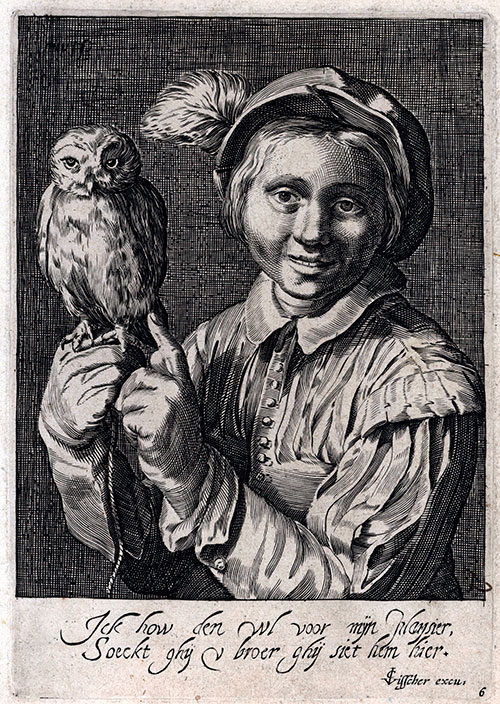
| |
Publisher CLAES JANSZ. VISSCHER
Amsterdam 1587 – 1652 Amsterdam
After CORNELIS & HENDRICK BLOEMAERT
Utrecht c1603-1692 Rome Utrecht c1601-1672 Utrecht
Visscher was an engraver and from 1606 also a publisher
and became the largest dealer of his day, specialising in buying
and reprinting older plates.
The Boy with an Owl
(After Hollstein 296)
175 x 121 mm
Engraving.
A reverse copy, with Hendrik Bloemaerts’ initials within
the image as in the original and with the same caption, but lacking
Cornelis’s initials as engraver, and with the addition of Visscher’s name
as publisher at the foot of the plate.
Laid down.
Sold
The Boy with an Owl was originally engraved for a series of four images
of boys with an animal, after a painting (now lost) by Hendrik Bloemaert
and engraved by his brother Cornelis Bloemaert, both sons of Abraham Bloemaert.
The Boy with an Owl belongs to a genre of comic print that equates
the viewer’s ancestry with the type of animal portrayed.
In this context the owl stands not for wisdom, but stupidity or folly,
as it did in contemporary folklore.
The print’s caption reads Ick how den wl voor mijn plaijsier, Soeckt ghij u broer ghij siet hem hier (Are you looking for your brother, you see him here).
The Bloemaert images were popular and copied a number of times.
This reverse copy, part of a series, was published, and possibly also engraved,
by Claes Jansz. Visscher, probably fairly soon after publication of the Bloemaert
prints.
Return to top ^ |
|
|
|
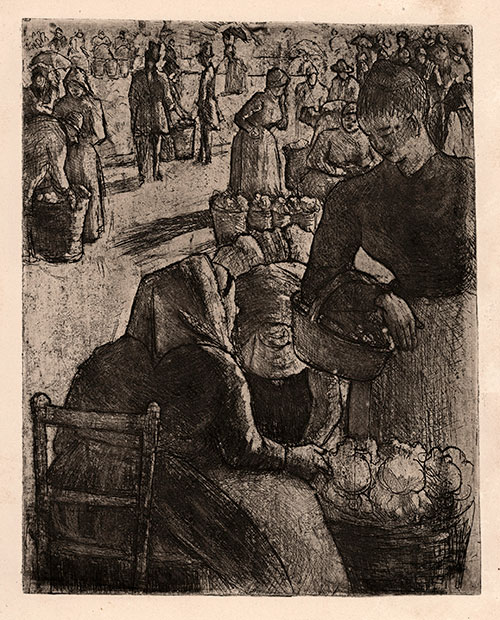
|
|
CAMILLE PISARRO
St Thomas, Danish Antilles 1830 – 1903 Paris
Pissarro settled in Paris in 1855 and within a few years gravitated into the
Impressionist circle of artists.
He had made a few etchings prior to 1879, but it was Degas, in that year,
who revived his interest and it became an important part of his œuvre.
He was the most devoted of the Impressionists to printmaking.
Marché aux Légumes à Pontoise
Vegetable market at Pontoise
Delteil 97 ii/ii
255 x 203 mm
Original etching with sugar lift aquatint, 1891.
Unsigned.
Unpublished in the artist’s lifetime, when only six proofs were printed.
Printed in brown-black ink on wove.
From the edition of 500 on wove
(there were also 76 on japan) published in Delteil’s Le Peintre Graveur Illustré
volume with the Pissarro catalogue, 1923.
Sold
Return to top ^ |
|
|
|
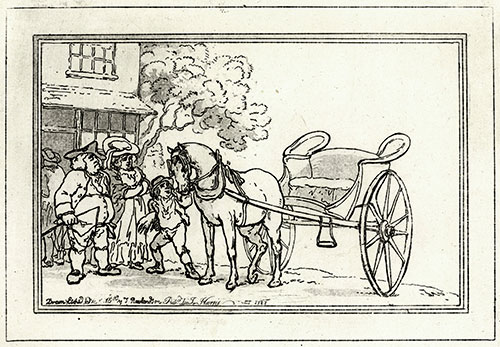 |
|
THOMAS ROWLANDSON
London 1757 – 1827 London
Rowlandson was a student at the Royal Academy Schools from 1772 -1778,
though he also spent a couple of years in Paris studying drawing.
He first exhibited at the Royal Academy, a watercolour drawing of Delilah
visiting Sampson, in 1775.
For some years he painted portraits before leaning increasingly to caricature.
Having inherited money from his aunt, he is said to have enjoyed the pleasures
of being a young man about town till the money ran out and he turned to caricatures
to provide him with an income.
Early in his career, in the later 1780’s, Rowlandson made two series of etchings
of rustic scenes with carts and carriages of all sorts, and the British Museum
website suggests this interest may relate to his maternal grandfather
who was a successful coachbuilder in London.
Ready to Depart is from 1787 (ref: see Grego pages 212-217)
Though the prints in the series were etched at different dates through the year,
they were presumably issued together in an album, for there are sewing holes
in the left margin of the sheet.
In their initial issues, none of the plates was titled.
Ready to Depart
188 x 256 mm (sheet); 135 x 209 mm (border)
Original etching with aquatint.
The plate signed and dated Dec 15th.
Published by J Harris 1787.
Trimmed to or just outside the plate on three sides; a 10 mm margin at the top.
Sold
Return
to top ^ |
|
|
|
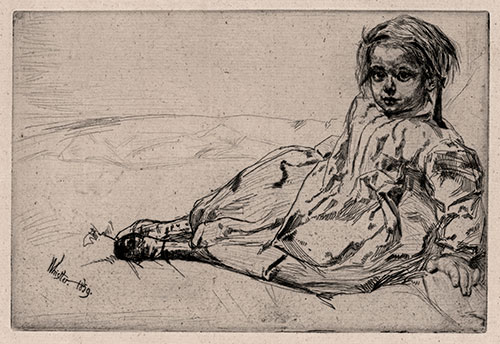 |
|
JAMES McNEILL WHISTLER
Lowell, Massachusetts 1834 – 1903 London
Whistler had his first success as an etcher, and launched his career with
the publication of his ‘French Set’ of etchings, Douze Eauxfortes d’après
Nature, in 1858.
His early etchings, made in Paris, show the influence of contemporary
French realism and naturalism, an awareness of the Barbizon etchers and
an admiration for Rembrandt.
Nine of the twelve plates Whistler etched in Paris in Autumn 1859 were portraits,
the first time he concentrated on the subject seriously.
Two were of children, both called Bibi.
Neither of the ‘Bibi’ plates was ever published.
Bibi Valentin
Glasgow 34 ii/ii ; Kennedy 50 ii/ii
152 x 225 mm
Original etching, 1859.
The plate signed and dated.
Unpublished.
Glasgow know of a total of 44 impressions.
This impression probably printed in the 1890’s? after the scratch
across the bed, which developed on the plate 1872-78, was removed.
On dark ivory thin laid paper.
Sold
The daughter of Valentin (possibly either the engraver Henry Augustus
Valentin or the sculptor J M Valentin).
Years later, in 1892, Mme Valentin wrote to Whistler
'Je vais vous paraître bien indiscrète en vous demandant une de vos
belles Eaux-fortes.
Celà me ferait un bien grand plaisir car nous n'avions de vous que
le portrait de ma fille, que vous aviez fait rue des Sts. Pères,
et qu'elle m'a repris depuis son mariage.'
'You will think me very indiscreet in asking you for one of your beautiful
Etchings.
It would give me great pleasure because the only work we have of yours
is the portrait of my daughter, which you had done in the Rue des Sts. Pères,
and which she took away when she married.'
Return
to top ^ |
|
|
|
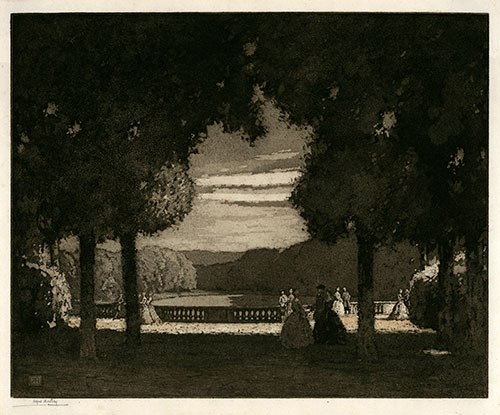 |
|
ALFRED HARTLEY R.E.
Stockham Pelham, Herts 1855 – 1933 Llandrindod Wells
Hartley was a student at the National Art Training School, South Kensington
(later renamed the Royal College of Art). He also attended Westminster School
of Art. He exhibited paintings from 1885.
Though he had started etching even before art school Hartley concentrated
on painting in his early career, before attending classes given by Frank Short.
In 1894 he was elected an Associate of the R.E.; a Fellow in 1897.
Nevinson, after his return from France in WW1, studied etching with Hartley.
From 1906 Hartley and his wife were regular visitors to St Ives, later settling
there until 1930. In 1922 he founded the New Print Society. He also exhibited
with the St Ives Society of Artists, founded in 1927.
Hartley’s earlier plates were etched, but by the early 1900’s, he had turned
to aquatint.
In either process he sort to express the specific quality of the light, be it sun
or moon.
He wrote in an article in The Studio in 1894 that the artist
“may suggest the breath of the morning air or the heat of the midday sun;
he may paint not only what he actually sees,
but something also of what he feels”.
Jardin au Grand Trianon
303 x 377 mm
Original aquatint, c1928.
The plate monogrammed.
Signed in pencil.
Printed in brown ink on cream laid paper.
£300
Exhibited at the Royal Academy 1928.
Return
to top ^ |
|
|
|
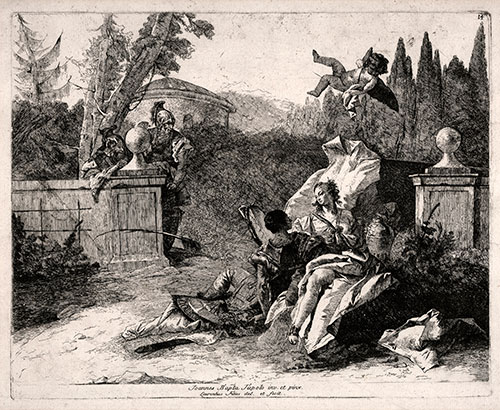 |
|
LORENZO TIEPOLO
Venice 1736 – 1776 Madrid
Lorenzo was one of two of Giovanni Battista Tieplo’s sons who worked
with their father. He was only thirteen when he accompanied his father
and elder brother, Domenico, to Würzburg to carry out the commission to
decorate the Residence of the Prince Bishop.
The family returned to Venice in 1753, until in 1762 King Charles III of Spain
commanded them to Madrid. When Giovanni Battista died in 1770, the elder
brother Domenico returned to Venice, but Lorenzo, who had fallen in love,
remained in Madrid and married in 1772, having set up as an independent artist.
He painted a few royal portraits but mainly specialised as a genre pastellist
and also made further etchings after his father’s works.
He lived only a few more years.
Rinaldo and Armida in her Garden
De Vesme 4 ii/ii
271 x 340 mm
Etching, c1755 or later, after the painting by Lorenzo’s father, Giovanni Battista Tiepolo.
Lettered with both artists’ names.
Second state with the number 14 in the top right corner,
probably c1770 for publication in a combination album of etchings by all three Tiepoli.
On laid paper watermarked with three crescents and the word Imperial.
With margins.
£2750
Scenes of the story of the Christian knight Rinaldo and the sorceress Armida,
from the epic Italian romance Gerusalemme Liberata by Torquato Tasso (1544-95)
about the first Crusade, were very popular with Italian and French artists in the 17th & 18th centuries.
Armida, initially set on revenge after Rinaldo has rescued his companions, falls in love and abducts him to her magic garden.
When two of Rinaldo’s companions come in search they find Rinaldo gazing at his own reflection
in Armida’s eyes while holding a mirror up to her face, so they were each seeing their own image in love.
Giovanni Battista Tiepolo decorated a room in the Venetian palace of the Cornaro family
with the story, c1742-45.
Four of the paintings from the scheme, including Rinaldo and Armida in her Garden,
reproduced in Lorenzo’s etching, are now in the Art Institute of Chicago.
Return
to top ^ |
|
|
|
|
|
|
|